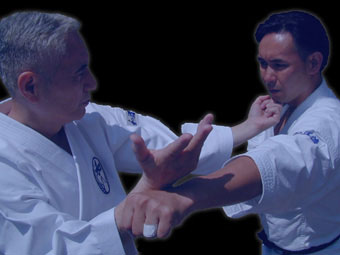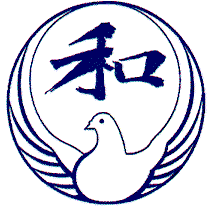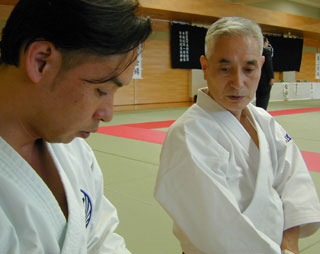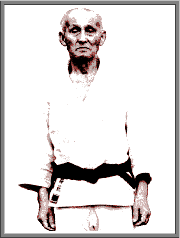Wado-Ryu Karate Founding Family Fights On
Most who meet the Captain are surprised to find that beyond the steel-trap mind, steady demeanor, and quick wit rest a variety of talents not usually associated with the news business. For example, many are shocked to find that twenty years ago his pop-lock breakdance moves dazzled thousands at malls throughout the Los Angeles area. And further stunned they are when it is revealed that three of his Texas saltwater fly fishing records from the early '70s remain untouched to this day. Yes, the Captain is a man of many hats.
 |
Hironori and Kazutaka show a few moves |
The martial arts, though, is something he has yet to tackle. (Even the Captain wouldn't include his drunken kicks and head-butts to uncooperative beer vending machines as counting as experience in the field.) But this week he takes his first lessons from a father and son team attempting to preserve one of karate's most famous styles. Tag along with for the fast and furious action.
Hironori Otsuka extends his right index finger and uses his left thumb to point to the location where the knife sliced through to the bone. The incident occurred during a Wado-Ryu karate demonstration that featured five defense routines. During this performance some years ago, his knife-wielding partner confused one routine for another.
"He made a mistake," Hironori, 69, says while taking a break during a recent Saturday karate demonstration at the Riverside Sports Center in Tokyo's Taito Ward. "But I should have remained calm in that situation. You can't fear anything."
Even though injuries in karate are typically broken front teeth and noses, this incident wasn't significant for its severity - there isn't even a scar today - but rather the lesson: maintaining composure and eliminating fear at all times is vital in the martial arts.
Today these time-held truisms are being strained outside the kicks and blocks that are applied daily at the dojo operated by Hironori and his 38-year old son Kazutaka in Tokyo's Nerima Ward. As the martial arts increasingly develops into a recreation dominated by sports competitions and marketing, this father and son team is battling to preserve the purity of the Wado-Ryu martial arts style began by Hironori's father, Grandmaster Otsuka, nearly 70 years ago.
In North America and Europe, the popularity of the Wado-Ryu style has spread remarkably in the last few decades, bringing a business aspect to this traditional craft. Sensing this, Hironori (who after changing his name from Jiro now shares the same name as his father) led a split from the original Wado-Ryu committee, Wado-Kai, to form Wado-Ryu Renmei just months before the death of Grandmaster Otsuka in 1982. The new group set itself to preserving the proper techniques of Wado-Ryu, leaving Wado-Kai to its business dealings.
 |
The Wado-Ryu Renmei logo |
The two groups may now be different (even using their own separate logos) but the name "Wado-Ryu" and Grandmaster Otsuka's image both remain highly marketable - this is the source of the Otsukas' problem.
In the early '90s, Dragon Associates Inc., located in Los Angeles, began selling videotapes ("Wado Ryu: The Way of Peace and Harmony") under the Wado-Kai logo that featured footage from some 60-mm instructional films of Grandmaster Otsuka demonstrating proper Wado-Ryu techniques. He had given them to a Japanese Wado-Ryu instructor, Yoshiaki Ajari, living in the U.S. about 40 years ago. For the videotape release, additional instruction material has been included to boost their length. The kicker is that this added material contains misleading Wado-Ryu moves.
"The technique is wrong," laments Kazutaka, sipping coffee before the day's demonstration, his large forearms visible within the wide arms of his white robe emblazoned with the blue Wado-Ryu Renmei logo. "They are using my grandfather as a product. Instructors using these tapes can get more students so they don't care."
When it was learned that a second volume was to be released in 1996, the Otsukas volunteered to present Dragon Associates with additional video material showing the proper Wado-Ryu style. But when representatives from Dragon Associates refused to meet at the airport in Los Angeles, the Otsukas went through the court system to force the company to release the tapes with markings indicating that footage is not official Wado-Ryu material. However, when the initial rulings did not go in their favor, and as court fees continued to mount, they threw in the towel.
"To be a professional at anything, you have to study it detail by detail," says Kazutaka, stressing the necessity for why incorrect Wado-Ryu moves cannot be confused with the real thing. "Then, when you understand one detail you will find another detail. It is an evolving process. Each detail cannot be easily explained [to a layman], but they are different."
 |
Kazutaka and Hironori take a break |
Wado-Ryu is a blend of Shotokan karate and the locking and arresting moves of jujitsu. Grandmaster Otsuka saw his variation as a softer, gentler form of defense compared to its other karate brethren; hence the name, meaning "way to harmony." Along with Shotokan, Shito-Ryu, Kyokushin, and Goju-ryu, Wado-Ryu is one of the most popular styles of karate around the world.
Unlike the powerful blows commonly featured in many karate styles, the Wado-Ryu technique typically employs speed with strikes and kicks that are light, not powerful. Evading the opponent is a key.
Kazutaka explains: "To study Wado-Ryu is difficult. Our style involves blocking and punching at the same time. Sometimes [in other karate styles] you will see a punch being blocked that would have finished away from the defender's body. That is a wasted move. There should be no defense in the martial arts. Defense and attack should be simultaneous."
Karate first began its development in Japan roughly 500 years ago on Okinawa. At the time, this island chain was a Chinese satellite under a strict ban on armed combat. Traditional mainland Chinese fighting styles then combined with this lack of weaponry to form the "empty hand" self defense form, the basis of what karate is today.
After World War II, many traditional martial arts were banned once again by the Allied Occupation. This provided a boom in the study of empty-handed forms like judo and karate. Instilling discipline and building character were the prime motivations. Today the practical need for such programs is rapidly decreasing.
"I feel it is getting difficult to teach martial arts in Japan," Kazutaka says. "We have branch dojos in many universities. But every year the number of students is decreasing. Most students want to a part-time job where they can get a little money. Nobody wants to endure hard training."
Even with this decline in interest, martial arts-related sports competitions are still hugely popular in Japan. These events might be based in the martial arts but their purpose is totally different.
 |
Grandmaster Otsuka |
K-1 is the greatest example. The sport's matches pit two massively built combatants from around the world against one another where a mix of kickboxing, Tae Kwon Do, and karate are utilized to crown a champion. Traditional martial arts aesthetics are tossed aside in favor of brute strength, glorified celebrity, and money. Any fighting skills of Bob Sapp, the sport's most recognizable figure, stand second to his coveted physique - the carved and sculpted bundle of power that is capable of setting young women's hearts a flutter and landing him lucrative commercials and print ads peddling Panasonic TVs and pizza.
Though the Otsukas do teach the sports aspect of Wado-Ryu, their primary focus is the preservation of the Grandmaster's style. Their public demonstration at the Riverside Sports Center is one of a half-dozen held yearly at various shrines and halls in Tokyo.
With Japanese versions of the Dragon Associates' tapes now available in Japan, the Otsukas are considering their next plan of attack. As to their motivations, money is certainly the last thing on their minds, Kazutaka maintains.
"We just don't want anyone to get the wrong idea about the techniques of Wado-Ryu," he says.

